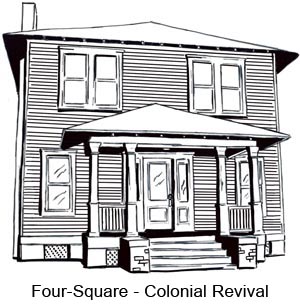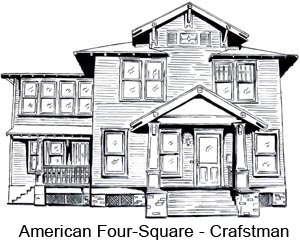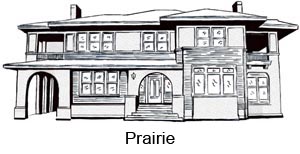




First Montrose Commons
Architectural Styles
Most of the historic buildings in First Montrose Commons are one- or two-story houses. Craftsman, Prairie, and Colonial Revival are the most common architectural styles in this neighborhood. A few Queen Anne houses — relatively late examples of that Victorian-era style — are also present.
First Montrose Commons contains several apartment buildings that were built between 1920 and 1940. These are relatively small, compared to today’s apartment buildings. They were constructed in the Art Deco, Colonial Revival, Renaissance Revival, Neoclassical, Tudor Revival, and Spanish Colonial Revival styles.
The “Victorian Era” lasted from 1837 to 1901. Many Victorian-era buildings were decorated with elaborate details. In America, this was called the Queen Anne style. Queen Anne houses could be one or two stories tall. They were relatively large and had irregular shapes and high-pitched roofs. Queen Anne details included intricate spindlework on the porch, and textured shingles or siding.
The Arts and Crafts Movement became popular in the early 1900s. It was a shift away from fancy Victorian architecture. Arts and Crafts emphasized order and restraint in the decorative arts. The Craftsman and Prairie building styles were developed during this period. Between 1900 and 1930, these were the most popular architectural styles in America.
The Craftsman style is often associated with a form of house called a bungalow. Both the Craftsman style and the bungalow were developed in California by Greene and Greene, a pair of architects who were brothers. Bungalows have low-pitched roofs with wide eaves. Decorations are prominent, but simplified. Craftsman houses are often identified by the brackets under the eaves of the roof. Craftsman details are often found on bungalows. Sometimes Craftsman details were applied to other types of houses, such as the American Four Square.
American Four Square houses are two rooms wide and two rooms deep. These houses may be one or two stories tall. In Houston, these are usually two-story houses with decorative details from the Craftsman, Prairie, or Colonial Revival styles.
Colonial Revival houses are meant to look like houses built around the time of the Revolutionary War. The most common Colonial Revival houses are two stories tall. They are rectangular, with a hipped or side-gabled roof. The front door is usually located in the center of the front façade. The door is often emphasized with a porch or decorative trim. Front windows are arranged symmetrically. Other shapes and configurations are also possible.
The Prairie style was developed in Chicago by architect Frank Lloyd Wright. It was used on large houses and on commercial buildings. Buildings in the Prairie style were more wide than tall, with mostly horizontal features. They were supposed to recall the flat, treeless plains of the Midwestern United States. Prairie houses are very common in the First Montrose Commons neighborhood.
Several apartment buildings in the neighborhood were constructed in the eclectic “revival” styles that were popular in the 1920s and 1930s. These imitated the architecture of other countries or their colonies in America. Spanish Colonial Revival, Dutch Colonial Revival, Tudor Revival, and Renaissance Revival styles are all found in First Montrose Commons. The district also has an Art Deco apartment building from the 1930s: the Sul Ross apartments at 808 Sul Ross Street.